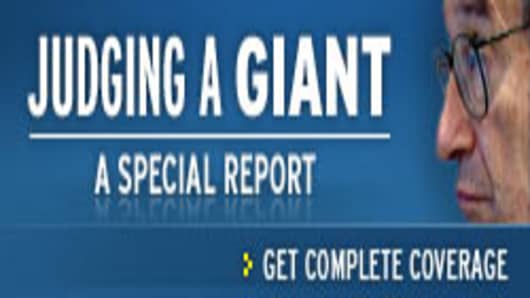Tracts about the Federal Reserve and its chairmen may not fill book shelves the way ones about the Constitution, the Supreme Court or presidents do, but they've become more common in recent years.
That's probably fitting given that the Chairman of the Federal Reserve Board post is often
referred to as the second most important job in Washington D.C. What's more, given the ascent of the global economy and its equally intertwined financial markets, Fed policy can send ripples far and wide.
Here's a look at some of the better known books about the Fed and its bosses, starting with the memoir of former chairman Alan Greenspan, whose long stewardship of the central bank started 20 years ago with his swearing in on August 11, 1987.
(The descriptions here represent summaries of reviews and synopses and are not meant as reviews unto themselves.)
The Age of Turbulence: Adventures in a New World
Alan Greenspan (The Penguin Press HC) (Available Sept. 17, 2007)
In his book, Greenspan shares the story of his life, while drawing readers along the same learning curve he followed. He reveals the universals of economic growth, delves into the specific facts on the ground in each of the major countries and regions of the world, and explains what the trend-lines of globalization are from here.
Secrets of the Temple: How the Federal Reserve Runs the Country
William Greider (Simon & Schuster)
Veteran Washington journalist, William Greider views the chairman as the second most powerful officer of government, its processes unknown to the public and yet to be fully understood by any modern president. He also asserts the "awkward little secret" that the federal government deliberately induces recessions, usually to bring down inflation and interest rates.
Politics of Money: The Fed Under Alan Greenspan
David M. Jones (New York Institute of Finance)
One of the first Fed watchers, veteran Wall Street economist David Jones focuses on the recent role of the Federal Reserve System and monetary policy. The book is a collection of a few key ideas and interpretive strategies.
Unlocking the Secrets of the Fed
David M. Jones (Wiley)
Jones explains how understanding and anticipating the actions of the Fed is critical to investment success. He also explains monetary and fiscal policymaking and offers practical information on the leading economic policy institution in the world,
Greenspan: The Man Behind Money
Justin Martin (Perseus Books Group)
Former Fortunemagazine staffer Justin Martin explains the intricacies of the financial system as well as reveals aspects of the enigmatic Fed chairman's private life. Martin's portrait lays out opposing views and lets readers draw their own conclusions.
The Fed: The Inside Story of How the World's Most Powerful Financial Institution Drives the Markets
Martin Mayer (Free Press)
Martin's book, one of his many on the world of finance, covers the day-to-day operations of the central bank as well as the Fed's role in the changing world of markets and high finance. The author, who gives Greenspan relatively high grades, also covers the Fed chairman's relationship with individual presidents and treasury secretaries.
A Term at the Fed: An Insider's View
Laurence H. Meyer (Collins)
Meyer, currently a scholar at the Center for Strategic and International Studies in Washington, DC., served as a Federal Reserve Board Governor from 1996-2002. The book covers his experiences at the Fed providing insights into the institution, policy decisions of that time and a host of individuals, including his boss, Greenspan.
The Secrets of the Federal Reserve
Eustace Mullins (Bankers Research Institute)
Mullins, an American political writer, describes in his controversial book that the Federal Reserve is unnatural and illegal within the American Constitution. The book contends that the Federal Reserve elite controls excessive interest rates, inflation and the printing of money.
The Case Against the Fed
Murray N. Rothbard (Ludwig Von Mises Institute)
Rothbard, the founder of libertarianism, covers the struggle between competing elites and how they converged with the Fed. He calls for the abolition of the central bank and a restoration of the gold standard and his treatment incorporates the best and most up-to-date scholarship on the Fed's origins and effects.
Paul Volcker: The Making of a Financial Legend
Joseph B. Treaster (Wiley)
Treaster of The New York Times, describes Paul Volcker’s life in private and public service. From his early days as a young Treasury Dept. official through his appointments to the New York Federal Reserve Bank and the Federal Reserve. The book explores the personal and professional ,dilemmas Volcker faced.
Alan Shrugged: Alan Greenspan, the World's Most Powerful Banker
Jerome Tuccille (Wiley)
American author Tuccille covers Greenspan's life from his birth in 1926 through early 2002. He recounts Greenspan's relationship with his mother, his two marriages, and his affinity for both mathematics and music. Although he played jazz professionally, Greenspan chose to follow his mathematical side and made a career in economics.
Changing Fortunes: The World’s Money and the Threat to American Leadership
Paul A. Volcker (Three Rivers Press)
Volcker, chairman of Federal Reserve from 1979-1987, writes about the significant international monetary affairs of the last four decades as seen from American and Japanese perspectives.
Maestro: Greenspan's Fed and the American Boom
Bob Woodward (Simon & Schuster)
Written by Washington Post legend Woodward, Greenspan’s biography deals with meetings of the FOMC, which makes headlines whenever it raises or lowers an interest rate. Recommended for collections dealing with modern politics and financial institutions.


